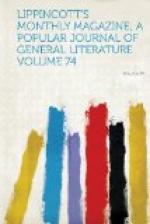They had not gone upward of a mile when a large force of the enemy appeared in their rear. The whites wheeled about at once, and were forming into line, when the whole body of Indians rushed upon them with great fury, shouting, “The Unacas are running! Come on! scalp them!” They attacked simultaneously the centre and left flank of the whites; and then was seen the hazard of going into battle with a many-headed commander. For a moment all was confusion, and the companies in attempting to form in the face of the impetuous attack were being broken, when Isaac Shelby rushed to the front and ordered each company a few steps to the rear, where they should reform, while he, with Lieutenant Moore, Robert Edmiston, and John Morrison, and a private named John Findlay,—in all five men,—should meet the onset of the savages. Instantly the six captains obeyed the command, recognizing in the volunteer of twenty-five their natural leader, and then the battle became general. The Indians attacked furiously, and for a few moments those five men bore the brunt of the assault. With his own hand Robert Edmiston slew six of the more forward of the enemy, Morrison nearly as many, and then Moore became engaged in a desperate hand-to-hand fight with an herculean chieftain of the Cherokees. They were a few paces in advance of the main body, and, as if by common consent, the firing was partly suspended on both sides to await the issue of the conflict. “Moore had shot the chief, wounding him in the knee, but not so badly as to prevent him from standing. Moore advanced toward him, and the Indian threw his tomahawk, but missed him. Moore sprung at him with his large butcher-knife drawn, which the Indian caught by the blade and attempted to wrest from the hand of his antagonist. Holding on with desperate tenacity to the knife, both clinched with their left hands. A scuffle ensued, in which the Indian was thrown to the ground, his right hand being nearly dissevered, and bleeding profusely. Moore, still holding the handle of his knife in the right hand, succeeded with the other in disengaging his own tomahawk from his belt, and ended the strife by sinking it in the skull of the Indian. Until this conflict was ended, the Indians fought with unyielding spirit. After its issue became known, they retreated."[002] “Our men pursued in a cautious manner, lest they might be led into an ambuscade, hardly crediting their own senses that so numerous a foe was completely routed. In this miracle of a battle we had not a man killed, and only five wounded, who all recovered. But the wounded of the enemy died till the whole loss in killed amounted to upward of forty."[003]
As soon as this conflict was over, a horseman was sent off to Watauga with tidings of the astonishing victory. “A great day’s work in the woods,” was Sevier’s remark when speaking subsequently of this battle.




